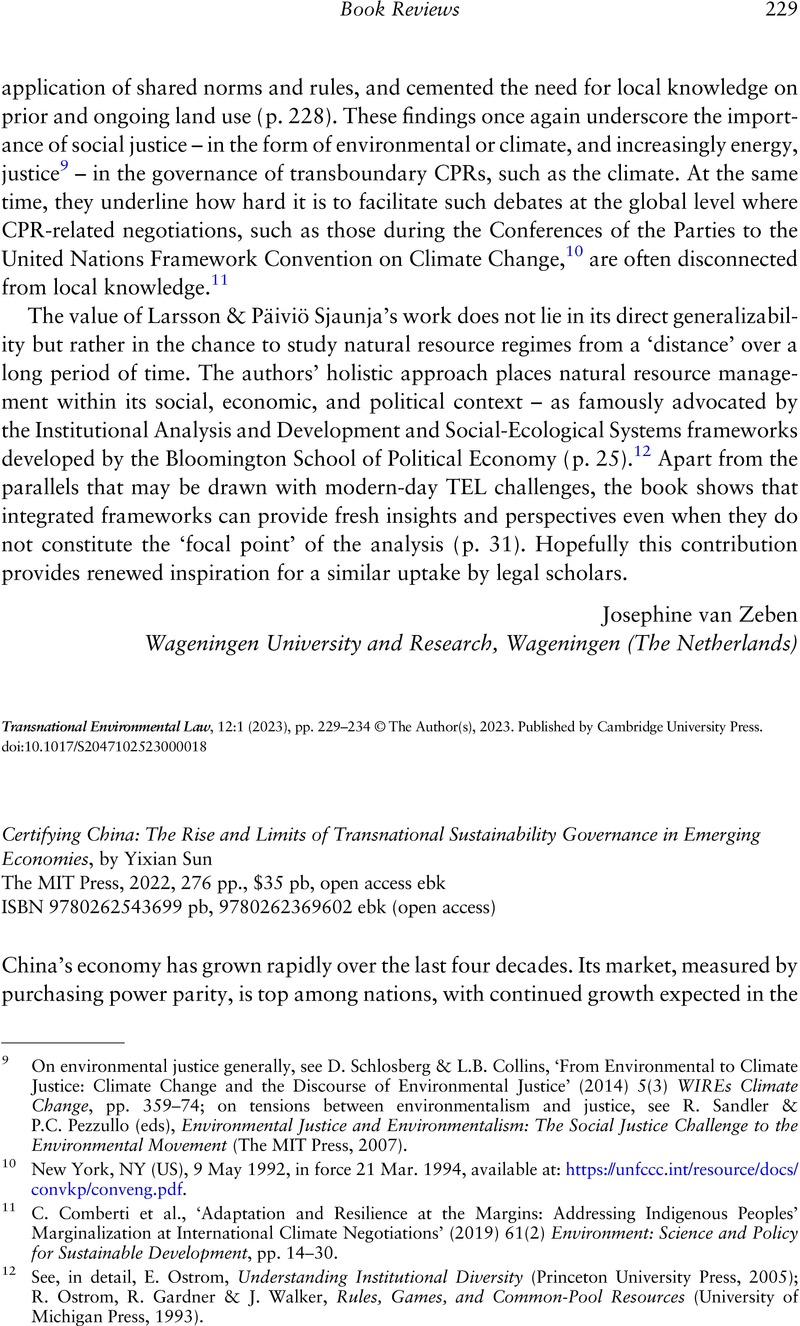No CrossRef data available.
Article contents
Certifying China: The Rise and Limits of Transnational Sustainability Governance in Emerging Economies, by Yixian Sun The MIT Press, 2022, 276 pp., $35 pb, open access ebk ISBN 9780262543699 pb, 9780262369602 ebk (open access)
Review products
Published online by Cambridge University Press: 22 March 2023
Abstract

- Type
- Book Reviews
- Information
- Copyright
- Copyright © The Author(s), 2023. Published by Cambridge University Press.
References
1 D. Zipser, J. Seong & J. Woetzel (for McKinsey and Company), ‘Five Consumer Trends Shaping the Next Decade of Growth in China’, 11 Nov. 2021, available at: https://www.mckinsey.com/cn/our-insights/our-insights/five-consumer-trends-shaping-the-next-decade-of-growth-in-china.
2 Sicular, T., Yang, X. & Gustafsson, B., ‘The Rise of China's Global Middle Class in an International Context’ (2022) 30(1) China & World Economy, pp. 5–27CrossRefGoogle Scholar.
3 For discussion of political consumerism in China, see Lei, Z., Liu, W. & Oosterveer, P., ‘Institutional Changes and Changing Political Consumerism in China’, in Boström, M., Micheletti, M. & Oosterveer, P. (eds), The Oxford Handbook of Political Consumerism (Oxford University Press, 2018), pp. 583–602Google Scholar.
4 Baron, D.P. & Diermeier, D., ‘Strategic Activism and Nonmarket Strategy’ (2007) 16(3) Journal of Economics & Management Strategy, pp. 599–634Google Scholar; Bartley, T., ‘Institutional Emergence in an Era of Globalization: The Rise of Transnational Private Regulation of Labor and Environmental Conditions’ (2007) 113(2) American Journal of Sociology, pp. 297–351CrossRefGoogle Scholar.
5 Cashore, B., Auld, G. & Newsom, D., Governing through Markets: Forest Certification and the Emergence of Non-state Authority (Yale University Press, 2004), pp. 224–7Google Scholar.
6 United Nations (UN), Department of Economic and Social Affairs, ‘The 17 Goals’, available at: https://sdgs.un.org/goals.
7 Auld, G., Gulbrandsen, L. & McDermott, C., ‘Certification Schemes and the Impacts on Forests and Forestry’ (2008) 33 Annual Review of Environment and Resources, pp. 187–211CrossRefGoogle Scholar.
8 Obach, B.K., Organic Struggle: The Movement for Sustainable Agriculture in the United States (The MIT Press, 2015), p. 192CrossRefGoogle Scholar; Auld, G., ‘Transforming Markets? Activists' Strategic Orientations and Engagement with Private Governance’ (2020) 33(1) Organization & Environment, pp. 31–55CrossRefGoogle Scholar.
9 Auld, Gulbrandsen & McDermott, n. 7 above.
10 See Friend of the Sea, ‘Certified Fisheries and Fleets’, available at: https://friendofthesea.org/approved-fisheries.
11 Cashore, Auld & Newsom, n. 5 above, pp. 42–3.
12 J.C. Marques & B. Eberlein, ‘Grounding Transnational Business Governance: A Political-Strategic Perspective on Government Responses in the Global South’ (2021) 15(4) Regulation & Governance, pp. 1209–29; V. Bitzer & G. Schouten, ‘Out of Balance: Global–Local Tensions in Multi-Stakeholder Partnerships and the Emergence of Rival Initiatives in Producing Countries’ (2022) Organization & Environment, available at: https://doi.org/10.1177/10860266221117231.
13 P. Foley & E. Havice, ‘The Rise of Territorial Eco-Certifications: New Politics of Transnational Sustainability Governance in the Fishery Sector’ (2016) 69 Geoforum, pp. 24–33.
14 Cashore, Auld & Newsom, n. 5 above, p. 22.
15 B. Cashore et al., ‘Revising Theories of Nonstate Market-Driven (NSMD) Governance: Lessons from the Finnish Forest Certification Experience’ (2007) 7(1) Global Environmental Politics, pp. 1–44.
16 S. Renckens, Private Governance and Public Authority: Regulating Sustainability in a Global Economy (Cambridge University Press, 2020); L. Partzsch, Alternatives to Multilateralism: New Forms of Social and Environmental Governance (The MIT Press, 2020); E. Partiti, Regulating Transnational Sustainability Regimes (Cambridge University Press, 2022).
17 Cashore, Auld & Newsom, n. 5 above.
18 J.H. McNichol, ‘Contesting Governance in the Global Marketplace: A Sociological Assessment of Business-NGO Partnerships to Build Markets for Certified Wood’ (Ph.D., University of California, Berkeley (US), 2002), pp. 269–70; E. Leitheiser, ‘How Domestic Contexts Shape International Private Governance: The Case of the European Accord and American Alliance in Bangladesh’ (2021) 15(4) Regulation & Governance, pp. 1286–303.
19 Cashore, Auld & Newsom, n. 5 above, pp. 206–7.
20 Ward, T.J., ‘Barriers to Biodiversity Conservation in Marine Fishery Certification’ (2007) 9(2) Fish and Fisheries, pp. 169–77CrossRefGoogle Scholar; Gulbrandsen, L.H. & Auld, G., ‘Contested Accountability Logics in Evolving Nonstate Certification for Fisheries Sustainability’ (2016) 16(2) Global Environmental Politics, pp. 42–60CrossRefGoogle Scholar.


